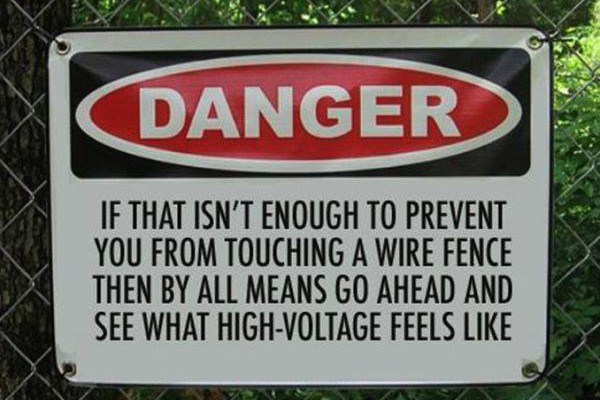Will Rogers once said “Good judgment comes from experience, and a lot of that comes from bad judgment”. While there’s certainly some truth in that statement, an awful lot of suffering can be avoided by recognizing some common warning signs. It’s been my experience that all the truly awful projects had one thing in common; dishonest people. I realize now, that every one of them put off some warning signs right at the beginning. So in hopes of sharing my hard-earned good judgment, I’m going to start with some background on why people disregard warning signs.

“I’ve got three good reasons why we should turn back…”
Judgment isn’t an insult
Right off, we have a popular perception that exercising judgment on the actions of others is an unkind or hurtful act. In simple terms judgment is the ability to make considered decisions or come to sensible conclusions. We have to exercise judgment to make good decisions. Estimators exist because there is uncertainty. If it were possible to simply add everything up, our job would be done by cashiers or accountants. It naturally follows that estimators must exercise their judgment if they are to do their jobs successfully. Estimators cannot afford to limit their perspective to the documents they’ve been provided. The project will happen in the real world, which means the uncertainty and risk of everything involved in the project should be considered. There are times where the people involved are the greatest risk of the project. Ignoring or underestimating the harm a key player can inflict, is a potentially ruinous mistake. If giving everyone the benefit of the doubt was a universal business practice, contracts wouldn’t lock in the estimated price.
Critical thinking
Getting back to influences that shift perspective, we must move to ethical reasoning. Critical thinking, also known as the Socratic Method is the classical means to grapple with moral dilemmas. The basis of the approach is a line of inquiry meant to draw out ideas and underlying premises. A series of hypotheses are presented, and each is tested to rule out those that lead to contradiction.
The clean and clinical Socratic Method takes a turn when you’re considering what to do with potentially dishonest people. It’s here that we entertain “devil’s advocate” or “how would you feel” arguments about the merit of your concern. I’ve worked with diplomatic and polite professionals who simply couldn’t bring themselves to see potential malice in others. Naiveté and bad judgment are constant companions. A lot of wrong-headed policy decisions are made by people who want to appear virtuous without doing the work to ensure a moral outcome.
For example: A General Contractor (GC) may become aware that their client isn’t conducting a fair bid. Their competitors are benefiting from additional time or information that’s not shared formally or equitably. Nevertheless, this GC upholds their “policy” of bidding according to the terms of the Request For Proposal (RFP) simply because they were invited to bid.
Virtue-signaling
Virtue-signaling, is more about the appearance of virtue, than acting with moral fortitude.

Sure Al could bike to work and avoid the traffic, but then nobody would see how superior he is.
In my example above, the GC is knowingly consuming their subcontractors (subs) time chasing a bid for an unethical client. Not only are they unlikely to win the job, they’d be contractually bound to a dishonest client if they did. Obviously it’s not the GC’s fault that their client is acting dishonestly. However the GC has options to act with integrity. The GC could contact the client with their concerns and withdraw from bidding if they were well-founded. The GC could also opt to submit a conceptual courtesy bid to give the client, their subs and themselves a face-saving exit from a bad situation.
Hope and second guessing
Entrepreneurs are an optimistic bunch. Seeing an opportunity in every difficulty is a critical component of their success. Estimating is a craft but lots of entrepreneurs start to see bidding strictly in terms of competition. Estimators may take pride in landing a few percentage points apart on bid-day because they’re aware of how hard it is to get to that total. Unfortunately, narrow losses are still losses. Tight markets increase the pressure on estimators to capitalize on every opportunity. Lots of desperate estimators jump at the chance to bid on turkey jobs because they’re hoping more than they’re thinking. Second-guessing your hard-won knowledge is using your best tools to build a trap for yourself.

Legitimacy and reciprocity
Take a moment to consider how construction estimating relates to clients, the market, and to contracts. From the RFP to the contract award there are a chain of events that proceed entirely on good faith. The client expects free bids from the GC’s according to the construction documents (CD’s) by their deadline in exchange for fairly awarding the contract to the winner of the bid.
There’s a lot to unpack in that last statement. The GC’s are committing their resources and the resources of their subs to providing a bid based on the client’s CD’s. Those resources are expensive and they are limited. So what’s in it for estimators facing lots of competition? The client is promising to fairly award the contract to the winning bidder. This obliges the client to prove the bid was fair by providing bid results to everyone. So each estimator is guaranteed to get either win a contract, or information on how to win their next bid. Anything that’s true at the Client-GC level is equally true at the GC-Sub level.
Estimators have an obligation to responsibly invest their company’s time in legitimate pursuits. Therefore the legitimacy of a potential opportunity, is dependent on the client’s reciprocity. Estimators must understand that a foolish investment cannot be recouped. So it is especially important to pay attention to early warning signs.

Warning signs
#1 The CD’s don’t support the clients schedule
For example, a client with a set of 50% complete drawings dated yesterday who claims they’re already in for permit so they can start the day after bid-day.
Unless the job is very small, it’s implausible that the clients design team could finish half their work in the time it would take you to bid the job. Even if that were the case, why pay to submit plans that aren’t likely to pass building department review if the completed drawings were forthcoming? The job is obviously not going to start when the client claims, so what is really going on? Bidding on incomplete drawings means that the estimator will have to creatively “fill in the blanks” of the design. Some clients use this ambiguity to request alternates or Value Engineering ideas for their project. These clients take the best ideas from the “free” bids and direct their design teams to include them in the final plans before putting the whole thing back out to bid. Feigning urgency and in need of assistance is a tactic to attract bidders looking to convert a conceptual estimate into a contract. I’ve seen clients who consumed so much of a GC’s time in estimating that the job was no longer profitable to build. That’s a very expensive way to give your competitor a job!
#2 The plans are ancient

“We’re working with a familiar design…”
Most legitimate projects on the hard-bid market will have plans that are dated within a month of the RFP. Design development can be a lengthy process that taxes the clients’ patience to get underway. Most clients are in a tremendous hurry to get their projects out to bid because it’s a major step in getting their project built. CD’s that are several months old could indicate that the project has previously bid. Savvy estimators might figure they must have come in over-budget so they’re re-bidding the job. They might be right, but it’s worth considering that a budget-blowout is cause for design/scope revision. Revised drawings get new dates, and that didn’t happen. Clients who simply felt they could get a better price by re-bidding are violating the basic reciprocity that makes them a legitimate client. They’re simply beating the bushes looking for someone below market value.
#3 The plans show more scope of work than the RFP requires
They’re called Contract Documents for a reason. The contract requires everything shown on the plans and specifications. Vague and/or informal instructions to “just bid this part” of a larger project creates a situation where the contractor can’t simultaneously follow instructions, and address their contractual risk. Why wouldn’t a legitimate client pay their design team to define the limits of project scope in a contractually enforceable manner? In my experience, these clients are feigning a competitive bid to collect information for later negotiations.
#4 The plans have the wrong address
Believe it or not, this is an incredibly common practice with chain stores and restaurants. Plans for a project in a different state are put out to bid with instructions to bid as though it’s identical to the proposed location. When the client won’t invest enough to revise their drawings for a new location, it’s a warning sign that they’re not sincere about writing a contract with you.
#5 The plans have a different contractors name on them
Its common practice for contractors engaged in design-build projects to have their names and logos put on the plans they develop. So when plans are put out to bid with a different contractors name on them, it’s an indication that a design-build contract fell through. Most contractors make their money on the build portion, so it’s unlikely that they’d happily give up that work. I’ve encountered situations where a competitor was suing the client because they were never paid for their design. It was difficult to imagine a successful project emerging from that debacle.

“Laugh all you want Tim, they’re your client now!”
#6 The client is still looking for money
Charity organizations are often obliged to fund their projects with some combination of pledge drives, donations and loans. There’s nothing wrong with that however an estimator needs to be aware of when a client’s ambition exceeds their finances. I’ve been to job walks for church remodels with a pledge drive “thermometer” showing they’d only raised a fraction of their goal. Those projects never got off the ground despite the client’s optimism.
#7 Unprofessional plans and bad clients
Clients tend to attract design teams with similar priorities. Truly excellent clients are generally willing to pay for the best professionals so their projects are successful. The worst design teams tend to work for clients with risky priorities. Projects that are run by committee like Education, Religious, and smaller Government facilities are bastions of poor decision-making. These groups are often seeking to spend their entire budget so they generally require a multitude of alternates that allow them the means to “upgrade” from their basic project without seeking additional funds. Vague, misleading, and incomplete plans are par for the course because these clients want to spend as little as possible on their design. In many cases, the committee members have no construction experience so decision-making and leadership will be haphazard at best. The design teams focusing on this market are well-versed in the arguments that poor plans create. No matter how incomplete the plans, these design teams will make certain they’ve laid all responsibility on the contractor.
#8 Past as prologue
Chain stores and restaurants have a tendency to use a “universal” design for all their locations. Over time, the company builds new stores and encounters change orders for something that was wrong in the plans. The client directs their design team to change the plans for all future work which generally takes the form of an added note on the plan. Over time this “universal” plan becomes inundated with obscure, trivial, and often pointless notes that solely exist to prevent change orders. The clients desire to avoid change orders creates a situation where the relevant scope is concealed from the bidders. A better plan would require fewer notes and would communicate more effectively, but the client isn’t willing to pay for that.
Similarly, clients with onerous RFP requirements designed to facilitate future arguments speak to the clients history. While it’s understandable that a client would want to avoid past mistakes, it’s worth considering what the client learned from that experience. Dishonest clients are often convinced that everyone is trying to cheat them. These clients tend to believe that cheating is simply a matter of beating the contractor to the punch.
#9 Nobody gets the same story
Clients and/or design teams that only answer questions off the record may pass it off as a means to rapidly respond, or to foster a “friendly” rapport with the GC. The bureaucratic process of writing an RFI, and getting it answered via an addendum is admittedly a lot of impersonal work. The great advantage of the formal process is that it’s the only way a bidder can change the contract documents. Moreover, the formal process also provides a measure of assurance that your competitor is getting the same information. If the client and their design team won’t provide direction formally, there’s a chance it won’t be a fair bid.
#10 The job has bid before
Reciprocity is tied to legitimacy and that’s especially true when it comes to clients who aren’t willing to award a contract to the low bidder. Lots of clients put their projects out to bid at the Schematic Design, and Design Development, stages to “check” that their design is within budget.

Conceptual bidding: a process of going nowhere until you reach your destination.
Unbridled optimism leads GC’s to think their conceptual estimate will be so good that the client awards the contract before the Construction Document’s are finalized. This process is known as “client capture” and it’s great when it works out. However unless the client has made promises to that effect, it’s more likely that the client expects this professional courtesy to be free of any reciprocal obligations.
There are some clients who maintain this perspective even on their “final” drawings. They are constantly beating the bushes for better prices by re-bidding the job with different contractors. Developers are particularly given to this practice. An absolutely staggering amount of market resources are wasted on these pricing exercises.
Clients aren’t the only ones who use this tactic, unethical GC’s who’ve won a bid will solicit new bids in a gambit to find a cheaper subcontractor. The subs who brought the GC their bid-day victory, are rewarded by a craven attempt to gain profitability via their competitors after the fact. Whether the GC is technically engaging in outright bid-shopping or not, it’s absolutely wrong.
You may discover your project was previously bid when vendor quotes are faster than normal and carry the date of the original bid. Distributors will often call subs to ask why something is bidding again. These same people will contact the previous bidders tipping them off that the job is back out to bid. GC’s who suddenly receive an early proposal from an uninvited sub may have good reason to suspect they’re not the first to bid the job.
As warning signs go, learning that a job has bid before should be cause for serious concern. There are very few legitimate reasons why a client would be forced to re-bid a job. Clients with contractors or financiers backing out of the deal would be a legitimate reason, however this is extremely rare. Subcontractors should be especially concerned about any GC who’s trying to get a sub proposal after the GC won a bid. The best case scenario is the GC had a sub back out on them. Any GC who’d accept proposals from hack bidders to win a contract isn’t willing to control the project’s risk. Why sign up to work with a rogues gallery of misfits who will drive the project into failure? It’s far more likely that the GC is trying to undercut the subs who helped them win in the first place. These GC’s won’t become more honest after contract award.
A note for the cynical
Oscar Wilde once said; “A cynic is a man who knows the price of everything and the value of nothing”. Estimators spend a lot of time figuring out what things should cost. It can be easy to lose sight of the bigger picture where estimating translates to controlling risk. Every enterprise will rely on people acting in their interests, in accordance with their nature. My answer to the cynics is to pay attention to people’s nature. Most of the problems we seek to guard against fall into patterns of behavior that are more complex than avarice. From the estimators point of view, there may be more risk in working for the indecisive, or ignorant than the greedy.
Many estimators fail to grasp the significance of picking good opportunities to pursue. Successful estimating starts with culling the lost causes, and the wastes of time. Impressing a client who won’t hire you isn’t worth much when your company needs work. It’s very important to understand that our industries malefactors are perfectly aware of how hopelessly optimistic contractors can be in hard times. Feigning legitimacy is their stock-in-trade so hard-times call for serious consideration of who you’re dealing with. Estimators working in a down market must recognize these warning signs as a basic survival skill. Working for a bad client in hard times has put many companies in dire straits. It doesn’t take much for a single bad job to pull an entire operation down. Estimators have a duty to protect their firms by heeding warning signs and steering a better course.
For more articles like this click here
© Anton Takken 2016 all rights reserved

March 26th, 2019 at 4:34 pm
Never knew this, thank you for letting me know.
LikeLike
October 19th, 2019 at 8:00 pm
Regards for all your efforts that you have put in this. very interesting information.
LikeLike